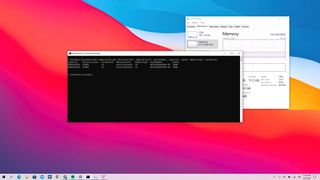How to get full PC memory specs (speed, size, type, part number, form factor) on Windows 10
Use these Windows 10 commands to quickly find memory module information without taking the computer apart or using third-party apps.

Windows 10 Check Ram Specs (Image credit: Windows Central)
On Windows 10, the ability to check the memory’s tech specs — RAM (Random Access Memory) — installed on your computer can come in handy in many situations. For example, when you have to troubleshoot hardware and software-related problems, and details like the manufacturer name, part number, and serial number can be useful when contacting technical support.
If your device is degrading performance as a result of memory-demanding applications or games, upgrading the memory can improve performance. Also, knowing the RAM specs can help determine the right size, speed, and brand to purchase a compatible upgrade kit.
Or when adjusting the memory settings in the Unified Extensible Firmware Interface (UEFI) or Basic Input/Output System (BIOS), the RAM information in advance will also help you know if the configuration has been applied correctly.
Whatever the reason might be, Windows 10 provides all the necessary information using Command Prompt without the need to open the device or install third-party tools.
In this Windows 10 guide, we will walk you through the steps to learn the technical specifications of the RAM installed on your computer, including part number, manufacturer, serial number, speed, capacity, form factor, memory type, etc.
How to check RAM specification using Command Prompt
While you can use Task Manager to view the memory specs information, if you want to determine more specific details, such as manufacturer, part number, serial number, and more, then you have several commands.
Check memory manufacturer
To determine the memory modules brand installed on the computer, use these steps:
- Open Start.
- Type Command Prompt, right-click the top result, and select the Run as administrator option.
- Type the following command to check the memory manufacturer name and press Enter: wmic memorychip get devicelocator, manufacturer
- Confirm the memory brand under the “Manufacturer” column.
Check memory part number
To find out the part number of each memory module on Windows 10, use these steps:
- Open Start.
- Type Command Prompt, right-click the top result, and select the Run as administrator option.
- Type the following command to determine the part number of the memory module and press Enter: wmic memorychip get devicelocator, partnumber
- Confirm the product number under the “PartNumber” column.
If your desktop computer feels sluggish, a RAM upgrade is perhaps one of the best ways to improve system performance. If you’re not sure which memory modules to purchase, our pick for most devices is the Corsair Vengeance LPX DDR4 16GB Kit. It has reliable performance and quality components, and it’s affordable.
Corsair Vengeance LPX DDR4 16GB kit
Best of DDR4
Since most modern processors from AMD and Intel can operate stably at 3200MHz, this Corsair kit with two 8GB modules is an ideal choice for most computer builds.
Check memory serial number
To find out the RAM serial number on your computer, use these steps:
- Open Start.
- Type Command Prompt, right-click the top result, and select the Run as administrator option.
- Type the following command to view the serial number for each memory stick and press Enter: wmic memorychip get devicelocator, serialnumber Quick tip: In the command, you can also replace “devicelocator” with “banklabel” to list the serial number showing the bank’s physical label where the memory is located on the motherboard. For example, wmic memorychip get banklabel, serialnumber
- Confirm the product identifier under the “SerialNumber” column.
Check memory capacity
Using Command Prompt, you can determine the total capacity per module and the entire system.
Determine capacity per memory module
To check each memory module capacity on Windows 10, use these steps:
- Open Start.
- Type Command Prompt, right-click the top result, and select the Run as administrator option.
- Type the following command to determine the memory capacity and press Enter: wmic memorychip get devicelocator, capacity
- Confirm the size of each memory module under the “Capacity” column.Quick tip: The capacity information is displayed in bytes, but you can divide the number by 1,073,741,824 (1 gigabyte in bytes) to convert the data into gigabytes.
Determine total system memory capacity
To find out the total amount of memory installed on the computer, use these steps:
- Open Start.
- Type Command Prompt, right-click the top result, and select the Run as administrator option.
- Type the following command to determine the total physical memory and press Enter: systeminfo | findstr /C:”Total Physical Memory”
- Confirm the total amount of physical memory (in megabytes) installed on the device.
Check memory module speed
To confirm the operating module speed, use these steps:
- Open Start.
- Type Command Prompt, right-click the top result, and select the Run as administrator option.
- Type the following command to determine the memory speed and press Enter: wmic memorychip get devicelocator, speed
- Confirm the speed of the memory modules (in MHz) under the “Speed” column
Check memory type
To check the system memory type on Windows 10, use these steps:
- Open Start.
- Type Command Prompt, right-click the top result, and select the Run as administrator option.
- Type the following command to determine the memory type and press Enter: wmic memorychip get devicelocator, memorytype
- Under the “MemoryType” column, confirm the number that identifies the type of memory. (See list below.)
Supported types
Memory types the command can identify:
Check memory form factor
To check whether the modules are DIMM or SODIMM, use these steps:
- Open Start.
- Type Command Prompt, right-click the top result, and select the Run as administrator option.
- Type the following command to check the memory form factor and press Enter: wmic memorychip get devicelocator, formfactor
- Under the FormFactor column, confirm the form factor information.Quick note: If the output is 8, the device uses DIMM modules (typically available on desktops). Otherwise, if the command output the number 12, the computer uses SODIMM modules (usually available on laptops).
Supported form factors
Form factors the command can identify:
Check all memory details
The above commands help you to determine the most useful information about the RAM installed on your computer. However, there is another command you can use to query all the available details at the same time.
To view all the memory details on Windows 10, then use these steps:
- Open Start.
- Type Command Prompt, right-click the top result, and select the Run as administrator option.
- Type the following command to list every memory detail possible and press Enter: wmic memorychip list full
- Confirm the available information for each memory module installed on the device.
- (Optional) Type the following command to view only the specific details and press Enter: wmic memorychip get devicelocator, manufacturer, partnumber, serialnumber, capacity, speed, memorytype, formfactor
- Confirm the memory information.
Once you complete the steps, you will have many details about the memory modules installed on your Windows 10 device.
While you can use Command Prompt to query many details about the RAM specifications on your computer, some information may not be available depending on the system’s hardware.
More Windows resources
For more helpful articles, coverage, and answers to common questions about Windows 10 and Windows 11, visit the following resources:
- Windows 11 on Windows Central — All you need to know
- Windows 11 help, tips, and tricks
- Windows 10 on Windows Central — All you need to know
Get the Windows Central Newsletter
All the latest news, reviews, and guides for Windows and Xbox diehards.
By submitting your information you agree to the Terms & Conditions and Privacy Policy and are aged 16 or over.

Mauro Huculak is technical writer for WindowsCentral.com. His primary focus is to write comprehensive how-tos to help users get the most out of Windows 10 and its many related technologies. He has an IT background with professional certifications from Microsoft, Cisco, and CompTIA, and he’s a recognized member of the Microsoft MVP community.
SEARCH RESULTS for: cmd368 live sportsbook [www.inz9my.com] CMD368 live betting, CMD368 sportsbook live, CMD368 in-play betting, CMD368 live odds, CMD368 live streaming, CMD368 sports betting live [www.inz9my.com].vch (0 results)
We anticipate reposting the images once we are able identify and filter out images that do not match the information provided in the drug labels.
- Home
- News
- DailyMed Announcements
- Get RSS News & Updates
- Advanced Search
- Browse Drug Classes
- Labels Archives
- Download Data
- All Drug Labels
- All Index Files
- All Mapping Files